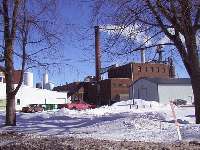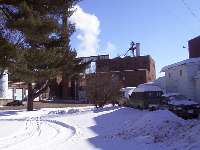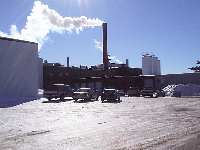The following is an excerpt from the collections of Ethel Matott, a school teacher in the Chippewa County school system.
Before many years passed, other settlers came to live near the falls. The elder Mr. and Mrs. Fred Pitsch were among them. During the 1880's, the Pitsch's and Ermatingers were going Black Berrying. As they were visiting the wagon went over a bump, throwing James Ermatinger out and he died of a broken neck.
Mr. and Mrs. Pitsch ran the company store at one time and also kept a Stopping Place. Part of the store is still in use by a grandson Ben Pitsch as a stable. Mr. Pitsch's son Fred has a home nearby. As I visited Mr. and Mrs. Fred Pitsch, looking out over the river, Mr. Pitsch described scenes of Logging Days. He also recalled the movements of the Indians when the made many treks South to Pow-Wow with the Menomonees. He was talking about the Chippewas'. As they came to the rapids in the river, forced to portage their birch bark canoes to smoother waters, they turned the Canoes upside down over the heads of the Squaws and with the Bucks walking with unencumbered, their women carried the family belongings around the Rapids.
One Indian, Joe Joko, a Chippewa would pull back his bow as if to shoot the Sioux Statue (in Holcombe) each time he went past it in his Canoe. It illustrated much hatred between the two tribes. Mr Pitsch recalls a Chippewa / Sioux battle fought along the Chippewa River which the Sioux were successful until the Chippewas' got them into the woods where the prairie Indians were unaccustomed to fighting. A warrior behind every tree helped the Chippewa defeat the Sioux. The two tribes differed in the behavior toward the white settlers. The Chippewa were quiet and peaceable often bringing venison and partridge to the post to be traded for supplies. They were generally honest and if they might have taken anything they in turn would bring something. as payment for it. The Sioux were an arrogant people probably walking into a house without knocking to snoop in the cupboards and boxes. The Settlers were afraid of them.
In 1863 a sawmill was built at the falls which had provided an economic life among the residents for some 20 years, then it burned down. (Rumor was that there had been an uncalled for series of problems concerning the passing through of other companies logs.)
Courtesy of Emil Gerber from the book
"The making of Jim's falls and Area"
Jim Falls is located between Chippewa falls and Cornell where county highway S and State 178 meet.
The plot to the left was as of 1913. The depot was located inside where the rails parted on the South-West portion of the split. A number of businesses developed as the rails headed North-East. The only one that remained serviced by the CNW at the time of the rail removal was Falls Dairy. The businesses also increased the community and other resources that the community needed. |
Home of the Sturgeon Festival
The Sturgeon Festival has been going on in Jim Falls for 70 plus years, and bringing multiple forms of entertainment to the local community. When it first started, horse pull competition and fishing for the largest Sturgeon were the main contests that brought avid fishermen and spectators from surrounding counties. Mix the historic festivities today with a parade, tractor and truck pulls, demolition derbies, and a carnival... what a great way to spend your labor day weekend, thanks to the local Lions Club.
Businesses Along the Rail
Jim Falls Dairy and a grain elevator were two of the main stops in Jim Falls Wisconsin. Milk was picked up along the route between Chippewa and Hannibal, loaded into chilled milk cars, and transported back to Falls Dairy. Grain was also picked up the the elevator and special feeds were delivered to the elevator to allow the local farmers to survive the long winters. Beside the dairy and Zutter's grain elevator there was also a fuel oil tank for the dairy, a potato warehouse, a pickle factory, and the depot on the same siding. The cars were staged at Chippewa or Altoona and all were exchanged at the same time from all of the businesses on the siding. A truck and a chain were used to reposition cars at the dairy waiting for the next pick-up schedule. Oil came in from Montana on occasion and contents were pumped into an above ground storage tank. This fuel was used for running the dairy.
| Old Abe the Civil War Eagle has his home town statue at Jim Falls WI. Donated by a local resident to the union during the Civil War, this eagle helped his regiment out and became a decorated war hero |
A view of today's actual shore line in the front of the area to be modeled
| Left side of layout, just before optional Power dam and truss bridges | Shoreline at middle left of layout |
| Shoreline near middle right of Jim Falls layout | Shoreline located at the far right of Jim Falls at entrance |

 
|
|
The Jim Falls Dairy from the front and rear. The tracks went between the brick and the tin buildings. The Fuel oil tank is still shown at lower right. The oil came from Montana at $300 a carload, plus shipping. |
If you have an
y information, stories, corrections, or pictures regarding this or any of the other towns along the Hannibal branch line, Please let me know, < E-mail > along with your permission to publish your personal memories in an attempt to keep the history available for future generations. Non-digital pictures and documentation will be returned upon request.Thanks
for looking,Doug Stoll